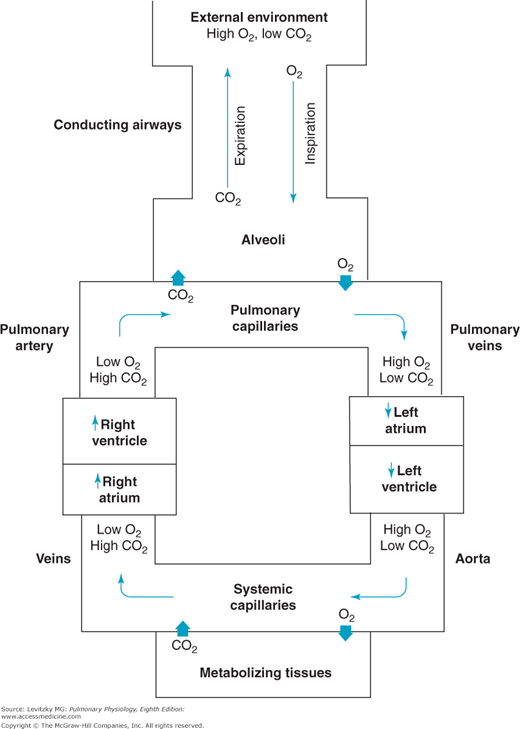Objectives
The reader states the functions of the respiratory system and relates the structural organization of the system to its functions.
- Describes the exchange of oxygen and carbon dioxide with the atmosphere and relates gas exchange to the metabolism of the tissues of the body.
- Defines the role of the respiratory system in acid-base balance.
- Lists the nonrespiratory functions of the lungs.
- Defines and describes the alveolar-capillary unit, the site of gas exchange in the lungs.
- Describes the transport of gas through the conducting airways to and from the alveoli.
- Describes the structural characteristics of the airways.
- Lists the components of the chest wall and relates the functions of the muscles of respiration to the movement of air into and out of the alveoli.
- Describes the central nervous system initiation of breathing and the innervation of the respiratory muscles.
Function and Structure of the Respiratory System: Introduction
![]() The main functions of the respiratory system are to obtain oxygen from the external environment and supply it to the cells and to remove from the body the carbon dioxide produced by cellular metabolism.
The main functions of the respiratory system are to obtain oxygen from the external environment and supply it to the cells and to remove from the body the carbon dioxide produced by cellular metabolism.
The respiratory system is composed of the lungs, the conducting airways, the parts of the central nervous system concerned with the control of the muscles of respiration, and the chest wall. The chest wall consists of the muscles of respiration—such as the diaphragm, the intercostal muscles, and the abdominal muscles—and the rib cage.
Functions of the Respiratory System
![]() The functions of the respiratory system include gas exchange, acid-base balance, phonation, pulmonary defense and metabolism, and the handling of bioactive materials.
The functions of the respiratory system include gas exchange, acid-base balance, phonation, pulmonary defense and metabolism, and the handling of bioactive materials.
Oxygen from the ambient air is exchanged for carbon dioxide produced by the cells of the body in the alveoli of the lungs. Fresh air, containing oxygen, is inspired into the lungs through the conducting airways. The forces causing the air to flow are generated by the respiratory muscles, acting on commands initiated by the central nervous system. At the same time, venous blood returning from the various body tissues is pumped into the lungs by the right ventricle of the heart. This mixed venous blood has a high carbon dioxide content and a low oxygen content. In the pulmonary capillaries, carbon dioxide is exchanged for oxygen from the alveoli. The blood leaving the lungs, which now has a high oxygen content and a relatively low carbon dioxide content, is distributed to the tissues of the body by the left side of the heart. During expiration, gas with a high concentration of carbon dioxide is expelled from the body. A schematic diagram of the gas exchange function of the respiratory system is shown in Figure 1–1.
In the body, increases in carbon dioxide lead to increases in hydrogen ion concentration (and vice versa) because of the following reaction:
The respiratory system can therefore participate in acid-base balance by removing CO2 from the body. The central nervous system has sensors for the CO2 and the hydrogen ion levels in the arterial blood and in the cerebrospinal fluid that send information to the controllers of breathing. Acid-base balance is discussed in greater detail in Chapter 8; the control of breathing is discussed in Chapter 9.
Phonation is the production of sounds by the movement of air through the vocal cords. Speech, singing, and other sounds are produced by the actions of the central nervous system controllers on the muscles of respiration, causing air to flow through the vocal cords and the mouth. Phonation will not be discussed in detail in this book.
Each breath brings into the lungs a small sample of the local atmospheric environment. This may include microorganisms such as bacteria, dust, particles of silica or asbestos, toxic gases, smoke (cigarette and other types), and other pollutants. In addition, the temperature and humidity of the local atmosphere vary tremendously. The mechanisms by which the lungs are protected from these environmental assaults are discussed in Chapter 10.
The cells of the lung must metabolize substrates to supply energy and nutrients for their own maintenance. Some specialized pulmonary cells also produce substances necessary for normal pulmonary function. In addition, the pulmonary capillary endothelium contains a great number of enzymes that can produce, metabolize, or modify naturally occurring vasoactive substances. These metabolic functions of the respiratory system are discussed in Chapter 10.
Structure of the Respiratory System
Air enters the respiratory system through the nose or mouth. Air entering through the nose is filtered, heated to body temperature, and humidified as it passes through the nose and nasal turbinates. These protective mechanisms are discussed in Chapter 10. The upper airways are shown in Figure 10–1
Stay updated, free articles. Join our Telegram channel

Full access? Get Clinical Tree



